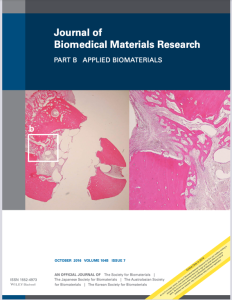• Book Chapter- 2020

Aesthetic Dental Implant Complications
Hossein Behnia, Navid Sharifzadeh, Parsa Behnia
Abstract
Since the early days of the discovery of dental implants, there has been a substantial paradigm shift from placing implants in edentulous ridges to rehabilitating the most complex cases in the aesthetic zone. The more implants are placed in the aesthetic zone, the more complications associated with this treatment protocol are developed. So, the need for documentation of aesthetic complications and definition of risk factors arises. Having enough information about advantages of the treatment modality, clinicians have to know its disadvantages correspondingly.
• Book Chapter-2017

Peri-Implant Soft Tissue Augmentation
Homayoun H.Zadeh, Diane Anthony-Costandy, Navid Sharifzadeh
• Article- 2017

The influence of initial alveolar ridge defect morphology on the outcome of implants in augmented atrophic posterior mandible: an exploratory retrospective study.
Arash Khojasteh, Saeed Reza Motamedian, Navid Sharifzadeh, Homayoun H. Zadeh
https://doi.org/10.1111/clr.12991
Abstract
Objectives
Clinicians commonly consider atrophic site topography as an important determinant in deciding the augmentation technique to utilize, as well as forecasting the likelihood of success. The purpose of this retrospective study was to examine the influence of initial atrophic posterior mandible morphology on the outcome of implants placed following augmentation.
Materials and methods
A total of 52 patients contributed 71 edentulous sites, and 185 implants were placed with mean follow-up of 37.97 months. The initial defect morphology was classified according to ABC classification (Journal of Oral Implantology, 37, 2013a and 361). Ridge augmentation was performed by “cortical autogenous tenting” (CAT) followed by either simultaneous or delayed implant placement after 4–6 months of healing. The European Academy of Osseointegration success criteria were used to evaluate implant outcomes.
Results
The overall survival and success rates of dental implants were 98.91% and 80%, respectively. Cumulative success and survival rates in CAT group were 95% and 100% after 2 years of follow-up. The highest marginal bone loss (MBL) was observed (1.26 mm ± 0.99) around implants placed in augmented edentulous sites with initially narrow and flat alveolar crest (defect class CII). Conversely, least MBL (0.48 mm ± 0.78) was detected around implants placed into edentulous sites with two sloped boney walls (defect class AII). Differences between MBL observed around implants placed into initial defect class C, initial defect type and class A (I, II), as well as class BII, were statistically significant (P < 0.05). Among all implants, 148 were considered as successful, 26 exhibited satisfactory survival, nine with compromised survival, and two implants failed.
Conclusion
The present data confirmed the effect of initial ridge morphology on the outcome of implants placed into augmented bone. Specifically, class A and class B atrophic ridge defects, with one and two vertical boney walls, respectively, may be considered as more favorable recipient sites than class C defects with flat morphology. This conclusion is based on least MBL around implants placed into initial defect class A and class B augmented sites, and higher MBL in implants placed into class C recipient sites. A randomized controlled trial is warranted to examine these exploratory observations.
• Article- 2015

Biomechanical analysis of engineered bone with anti-BMP2 antibody immobilized on different scaffolds
Sahar Ansari, Jin-Ho Phark, Sillas Duarte Jr, Maike Paulino da Silva, Navid Sharifzadeh, Alireza Moshaverinia, Homayoun H. Zadeh
Abstract
Recently we have demonstrated the ability of monoclonal antibodies (mAb) specific for bone morphogenetic protein (BMP)-2 immobilized on different scaffolds to mediate bone formation, a process referred to as Antibody Mediated Osseous Regeneration (AMOR). One of the key properties of regenerated bone is its biomechanical strength, in particular in load-bearing areas. This study sought to test the hypothesis that the biomechanical strength of regenerated bone depends of the mode of regeneration, as well as the scaffold used. Four different scaffolds, namely titanium granules (Ti), alginate hydrogel, anorganic bovine bone mineral (ABBM), and absorbable collagen sponge (ACS) were functionalized with anti-BMP-2 or isotype control mAb and implanted into rat critical-size calvarial defects. The morphology, density and strength of the regenerated bone were evaluated after 8 weeks. Results demonstrated that scaffolds functionalized with anti-BMP-2 mAb exhibited varying degrees of bone volume and density. Ti and ABBM achieved the highest bone volume, density, and strength of bone. When anti-BMP-2 mAb was immobilized on Ti or ABBM, the strength of the regenerated bone were 80% and 77% of native bone respectively, compared with 60% of native bone in sites implanted with rh-BMP-2. Control interventions with isotype mAb did not promote considerable bone regeneration and exhibited significantly lower mechanical properties. SEM analysis showed specimens immobilized with anti-BMP-2 mAb formed new bone with organized structure bridging the crack areas. Altogether, the present data demonstrated that the morphological and mechanical properties of bone bioengineered through AMOR could approximate that of native bone, when appropriate scaffolds are used. © 2015 Wiley Periodicals, Inc. J Biomed Mater Res Part B: Appl Biomater, 104B: 1465–1473, 2016.

One Response
Wonderful publications Dr Sharifzadeh. Looking forward to seeing more publications especially on the topic of Implant complications management. It seems that hard work has just begun. Wishing you great success.